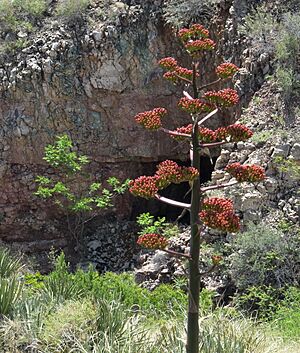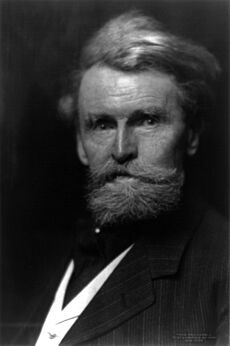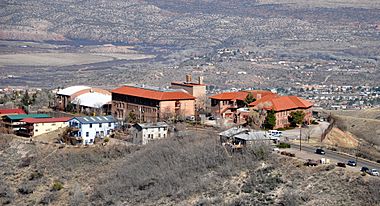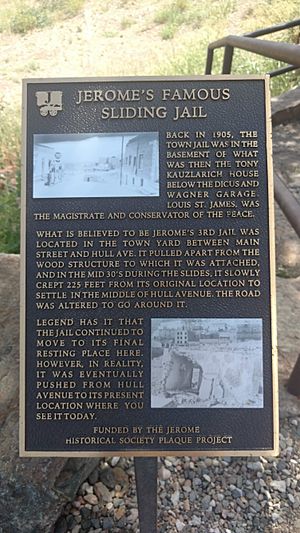Jerome, Arizona facts for kids
Quick facts for kids
Jerome, Arizona
|
||
|---|---|---|
|
Town
|
||
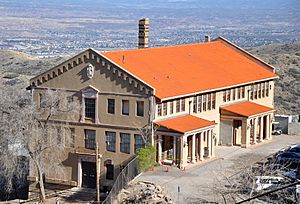
Civic Building in 2013
|
||
|
||
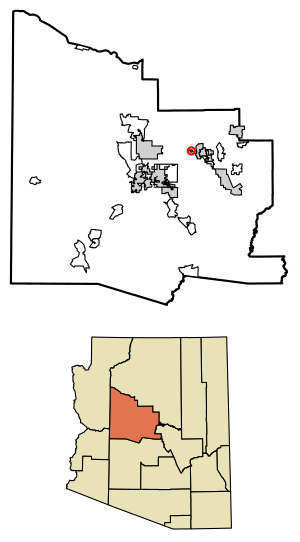
Location of Jerome in Yavapai County, Arizona
|
||
| Country | ||
| State | ||
| County | Yavapai | |
| Incorporated | 1899 | |
| Area | ||
| • Total | 0.79 sq mi (2.04 km2) | |
| • Land | 0.79 sq mi (2.04 km2) | |
| • Water | 0.00 sq mi (0.00 km2) | |
| Elevation | 5,066 ft (1,544 m) | |
| Population
(2020)
|
||
| • Total | 464 | |
| • Density | 590.33/sq mi (227.90/km2) | |
| Time zone | UTC−7 (MST) | |
| ZIP Code |
86331
|
|
| Area code(s) | 928 | |
| FIPS code | 04-36290 | |
| GNIS feature ID | 30522 | |
| Website | Town of Jerome | |
| Population density has been calculated by dividing population by land area and rounding to the nearest hundred per square mile. | ||
Jerome is a town in the Black Hills of Yavapai County in the U.S. state of Arizona. It was founded in the late 1800s on Cleopatra Hill, high above the Verde Valley. Jerome is over 5,000 feet (1,500 meters) above sea level. It's about 100 miles (160 km) north of Phoenix. You can find it along State Route 89A between Sedona and Prescott.
In the 1920s, over 10,000 people lived here because of its rich copper mines. As of the 2020 census, Jerome has a population of 464 people.
The town exists mainly because of two huge ore deposits. These formed about 1.75 billion years ago inside an undersea volcano. Over time, these deposits were pushed closer to the surface. Miners found copper, gold, silver, and other metals here. The copper deposits near Jerome were some of the richest ever found.
Jerome made news in 1917 because of worker disagreements. About 60 members of a group called the Industrial Workers of the World (IWW) were forced to leave town. They were put on a cattle car and sent away. Mining production boomed during World War I, then fell. It rose again, then fell during and after the Great Depression. When the ore ran out, the mines closed in 1953. The town's population dropped to fewer than 100 people.
To save the town, residents started focusing on tourism and shops. Jerome became a National Historic Landmark in 1967. By the early 2000s, it had art galleries, coffee shops, restaurants, a state park, and a museum about mining history.
Contents
Exploring Jerome's Location
Jerome is about 100 miles (160 km) north of Phoenix. It is also about 45 miles (72 km) southwest of Flagstaff. You can find it along Arizona State Route 89A between Sedona and Prescott.
The town is located in Arizona's Black Hills. These hills run from north to south. Jerome is inside the Prescott National Forest at over 5,000 feet (1,500 meters) high. Woodchute Wilderness is about 3 miles (5 km) west of Jerome. Mingus Mountain, which is 7,726 feet (2,355 meters) high, is about 4 miles (6 km) south.
Jerome State Historic Park is right in town. Bitter Creek, a small stream that flows into the Verde River, sometimes runs through Jerome. East of Jerome, at the bottom of the hills, are the Verde Valley and the towns of Clarkdale and Cottonwood. Cottonwood has the closest airport.
How Jerome's Land Was Formed
Most of Cleopatra Hill, where Jerome was built, is 1.75 billion years old. It was formed by a huge volcano eruption under the sea. This happened in ancient seas south of what is now northern Arizona. Cold seawater then entered cracks in the Earth's crust. Hot magma heated this water to over 660°F (350°C). The hot water rose, changing the rocks and picking up dissolved minerals.
When this hot water came out of hydrothermal vents on the ocean floor, the minerals hardened. They fell to the seafloor, forming the ore bodies. These two ore bodies, called United Verde and UVX, became very important to Jerome's mining.
About 50 million years later, the land where these ores were located collided with another landmass. This collision folded the rocks, placing the two ore bodies on opposite sides of a fold called the Jerome anticline.
Later, about 525 million years ago, northern Arizona was under a shallow sea. A thin layer of sand, called the Tapeats Sandstone, covered the older rocks. Other sediments piled up on top of this. Around 70 million years ago, new mountains and faults formed. One fault, the Verde Fault, runs right under Jerome.
About 15 million years ago, the Earth's crust began to stretch. This created the Basin and Range landscape in Arizona. It also caused volcanic activity near Jerome. This movement exposed the tip of the United Verde ore body. It also moved the UVX ore body to about 1,000 feet (300 meters) below the surface.
Mining greatly changed the natural rock features around Jerome. The town has about 88 miles (142 km) of mine shafts underground. These tunnels might have caused some of Jerome's buildings to slowly slide downhill. The United Verde open pit mine, about 300 feet (90 meters) deep, is on the edge of town. Mining here stopped in 1953.
Jerome's Past: From Ancient Times to Mining Boom
Early Inhabitants
The Hohokam people were the first known to live and farm near Jerome. They were here from 700 to 1125 CE. Later, other native peoples likely mined the United Verde ore body. They used the colorful copper minerals like malachite and azurite. The top of the ore body was easy to reach because it was visible on the surface.
The first Europeans to arrive were Spanish conquistadors. They were looking for gold and silver, not copper. In 1585, Spanish explorers noticed the ore but did not mine it.
The 1800s: Mining Begins
In 1876, Angus McKinnon and Morris A. Ruffner made the first claims for copper mining here. In 1880, Frederick A. Tritle, the governor of Arizona Territory, and Frederick F. Thomas bought these claims. In 1883, they started the United Verde Copper Company. They named the small mining camp Jerome after Eugene Jerome, one of their financial supporters from New York City.
United Verde built a small smelter in Jerome. They also built wagon roads to transport ore. But wagon transport was expensive. In late 1884, the price of copper dropped by half, and the company stopped all work.
Four years later, William A. Clark bought the United Verde properties. He had made a lot of money in mining in Montana. Clark improved the smelter and built a narrow gauge railway. This railway, the United Verde & Pacific, went to Jerome Junction, 27 miles (43 km) away.
As mining grew, Jerome's population jumped from 250 in 1890 to over 2,500 by 1900. The United Verde Mine became the top copper producer in Arizona. It employed about 800 men and was one of the world's largest mines. Over 77 years (1876 to 1953), this mine produced almost 33 million tons of copper, gold, silver, lead, and zinc ore. The metals from United Verde and UVX, another big mine, were said to be worth over $1 billion. The copper deposits in Jerome were among the richest ever found.
Jerome got a post office by 1883. It added a schoolhouse in 1884 and a public library in 1889. Between 1894 and 1898, four big fires destroyed much of the town. Jerome became an official town in 1899. This allowed it to collect taxes for a fire system and building rules. These rules stopped people from building tents, which were fire risks. William Munds was the first mayor.
By 1900, Jerome had churches, clubs, and a downtown with brick buildings. It also had telephone service and electric lights.
The Early 1900s: More Mining and Challenges
Jerome was not a "company town," even though it relied on one main company. In 1914, a separate company, United Verde Extension Mining Company (UVX), found another huge ore body. This mine, also called the Little Daisy Mine, became very profitable. In 1916 alone, it made $10 million worth of metals, with $7.4 million in profit. This mine eventually produced over $125 million worth of ore.
Starting in 1914, World War I greatly increased the need for copper. By 1916, 22 companies were mining near Jerome. About 3,000 miners worked in the area. United Verde built a large smelter and a company town called Clarkdale. They also built a new railway to carry ore to the new smelter. After the new railway opened in 1915, the Jerome smelter was taken apart. The mine became an open-pit operation by 1919.
The change from underground to open-pit mining helped control fires in the mine's sulfur-rich ores. By 1918, UVX also had its own smelter in its own company town, Clemenceau. In 1929, a company called Verde Central opened another mine near Jerome.
Worker relations in Jerome were complex. Three different worker groups had members in Jerome. These included the International Union of Mine, Mill, and Smelter Workers (MMSW) and the Industrial Workers of the World (IWW). There was also the Liga Protectora Latina, which represented about 500 Mexican miners.
In 1917, two miner strikes involving the IWW happened in Jerome. The IWW was seen as a threat by businesses and other worker groups. The MMSW, which had called a strike earlier, did not like the IWW. They would not recognize the IWW as a real group.
In July, the IWW called for a strike at all the mines. The MMSW voted against this strike. Three days later, about 250 armed citizens gathered up at least 60 suspected IWW members. They put them on a railroad cattle car and sent them out of town. This event is known as the Jerome Deportation.
After 1920: Decline and Rebirth
After a short slowdown, good times returned to Jerome in the 1920s. Copper prices went up, and the mines worked at full speed. Wages increased, people spent money, and town businesses did well. United Verde added benefits for its workers. It also built a baseball field, tennis courts, swimming pools, and a public park in Jerome. Both mining companies helped fund the library, schools, churches, and hospitals.
In 1930, when the Great Depression started, copper prices fell sharply. United Verde began reducing its workers. UVX lost money, and Verde Central mine closed. Copper prices fell even more in 1932. This led to layoffs and wage cuts. In 1935, the Clark family sold United Verde to Phelps Dodge. In 1938, UVX went out of business.
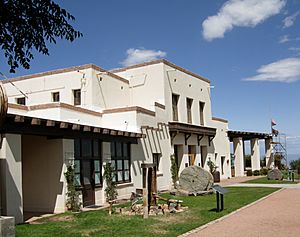
Meanwhile, a problem with the ground sinking got worse through the 1930s. By 1928, at least 10 downtown buildings were damaged. Dozens of buildings, including the post office and jail, were lost as the ground beneath them sank. This was caused by natural faults, mine blasts, and erosion.
Mining continued at a lower level until 1953. Then, Phelps Dodge closed the United Verde Mine for good. Jerome's population dropped to fewer than 100 people. To save the town, the remaining residents focused on tourism and shops. They started the Jerome Historical Society in 1953. They opened a museum and gift shop.
To attract tourists, the town leaders sought National Historic Landmark status. The government granted it in 1967. In 1962, James Douglas's family gave the Douglas mansion to Arizona. This became Jerome State Historic Park. The community hosted music festivals, home tours, and races. These events brought visitors and new businesses. Today, Jerome has art galleries, craft stores, wineries, coffee shops, and restaurants.
Jerome's Weather
July is usually the warmest month in Jerome. Highs average 90°F (32°C), and lows average 67°F (19°C). January is the coldest month. High temperatures average 50°F (10°C), and lows average 33°F (1°C). The highest temperature ever recorded was 108°F (42°C) in 2003. The lowest was 5°F (-15°C) in 1963.
August is the wettest month, with about 3 inches (76 mm) of rain. Spring months from April to June usually do not have much rain. While most rain falls as rain, snow and fog sometimes happen. On average, about 5 inches (13 cm) of snow falls in January. Smaller amounts fall in other winter months. Jerome is often windy, especially in spring and fall. Summer thunderstorms can be strong.
According to the Köppen climate classification, Jerome has a Mediterranean climate.
Jerome's People
| Historical population | |||
|---|---|---|---|
| Census | Pop. | %± | |
| 1890 | 250 | — | |
| 1900 | 2,861 | 1,044.4% | |
| 1910 | 2,393 | −16.4% | |
| 1920 | 4,030 | 68.4% | |
| 1930 | 4,932 | 22.4% | |
| 1940 | 2,295 | −53.5% | |
| 1950 | 1,233 | −46.3% | |
| 1960 | 243 | −80.3% | |
| 1970 | 290 | 19.3% | |
| 1980 | 420 | 44.8% | |
| 1990 | 403 | −4.0% | |
| 2000 | 329 | −18.4% | |
| 2010 | 444 | 35.0% | |
| 2020 | 464 | 4.5% | |
| Census sources 1890–1990, 2000 and 2010 | |||
The people living in early Jerome were very different from today. At first, ranchers and prospectors from North America filed mining claims. But as the mines grew, workers from many different backgrounds arrived. These included people of Irish, Chinese, Italian, and Slavic origin in the late 1800s.
By World War I, many Mexican nationals arrived. In 1930, about 60 percent of the town's residents were Latino. Mining company records show that about 57 percent of UVX workers were Mexican nationals in 1931. Workers born outside the U.S. or with Spanish last names made up about 77 percent of the UVX workforce.
The number of females compared to males also changed a lot over time. From 1900 to 1950, the percentage of female residents slowly grew. They were only 22 percent of the population in 1900 but about 50 percent by the mid-1900s.
As of the census of 2010, Jerome had 444 people living in 253 households. Of these, 93 were families. The residents were nearly 94 percent White. The rest were listed as Black, Native American, Asian, or other groups. About 6 percent of the population was Hispanic or Latino. The population was almost evenly split between 226 women (median age 54) and 218 men (median age 55).
By the 2020 census, the population grew to 464. The average household income was about $35,000. About 19 percent of the population was Hispanic or Latino.
Life in Jerome: Economy and Culture
Jerome's economy mostly depends on recreation and tourism. In 2015, over half of the workers were in arts, entertainment, retail, food, and recreation services. Manufacturing and construction employed just over 10 percent. Between 1990 and 2006, the value of sales increased from $4.8 million to $15.5 million. The unemployment rate fell from 4.2 to 1.4 percent between 1990 and 2014.
Empty buildings now house boutiques, gift shops, and antique stores. The town also has five art galleries, a library, three parks, and two museums. One museum is the Mine Museum, run by the Jerome Historical Society. Another is a former church building that holds the society's offices and old records.
Yearly events include a home tour in May, a reunion for old mining families in October, and a Festival of Lights in December. Gulch Radio KZRJ broadcasts from Jerome at 100.5 FM. The Town of Jerome publishes a newsletter called Point of View every two months.
Town Services and Buildings
School Buildings
Children from Jerome in kindergarten through eighth grade go to the Clarkdale–Jerome School in Clarkdale. Older students attend Mingus Union High School in Cottonwood. Both of these towns had their own schools in the early 1900s. But as populations dropped and tax money shrank, schools combined. The old Jerome High School complex now holds many artists' galleries.
The Sliding Jail
In March 2017, the Jerome Historical Society took over the old jail, now called the Sliding Jail. It became unusable because the ground moved since the 1930s. The building is now about 200 feet (60 meters) downhill from where it was first built. It has become a popular place for tourists to visit.
Town Utilities
Jerome manages its own water system. The water comes from ten mountain springs. The town's 2016 water report said Jerome's water met all state and federal rules and was safe to drink. Jerome also runs its own sewer system, trash collection, and recycling services. Its public works department takes care of these systems. They also maintain the streets, parks, and other town property.
Arizona Public Service provides electricity to Jerome. UniSource Energy Services supplies natural gas. Several companies offer Internet access, including Century Link (DSL), HughesNet (satellite), and Speed Connect (fixed wireless). Satellite television is available through DirecTV and the Dish Network. Mobile phone companies and Century Link offer telephone services.
Famous People from Jerome
- Maynard James Keenan (born 1964), singer for the rock music bands Tool, A Perfect Circle and Puscifer. He also founded Caduceus Cellars, which has a vineyard in Jerome.
- Katie Lee (1919−2017), a folk singer and environmental activist. She lived in Jerome when she passed away.
- Fred Rico (born 1944), a Major League Baseball player, was born in Jerome.
See also
 In Spanish: Jerome (Arizona) para niños
In Spanish: Jerome (Arizona) para niños







